|
|
|
Sort Order |
|
|
|
Items / Page
|
|
|
|
|
|
|
| Srl | Item |
| 1 |
ID:
073503
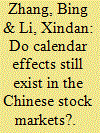

|
|
|
|
|
| Publication |
2006.
|
| Summary/Abstract |
The paper uses rolling sample tests to investigate time-varying calendar effects in the Chinese stock market, based on the GARCH (1, 1)-GED model. The Friday effect existed with low volatility at the early stage, but it seems to have disappeared since 1997. The positive Tuesday effect began to appear then. There is a small-firm January effect with high volatility. The turn-of-the month effect has also disappeared in the Chinese stock market since 1997.
|
|
|
|
|
|
|
|
|
|
|
|
|
|
|
|
| 2 |
ID:
121279
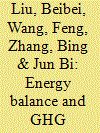

|
|
|
|
|
| Publication |
2013.
|
| Summary/Abstract |
Cassava-based fuel ethanol (CFE) is playing an increasingly important role in renewable transportation energy in the Guangxi Province in China. Previous studies have evaluated the energy and greenhouse gas (GHG) performance of CFE, but they have largely overlooked the influences of different agricultural planting modes. In this study, five scenarios related to cassava planting modes were selected to evaluate the lifecycle energy balance and GHG emissions of the CFE system. The results show that, although all the five CFE scenarios show positive net energy values (NEV) and GHG emissions savings compared with the conventional gasoline, the planting modes have significant impacts on their energy and GHG performance. Modes that are considered intensive (i.e. high fertilizer use intensity and highly mechanized harvesting) generally show poorer performance than the extensive ones, primarily because of the intensive energy consumption and GHG emissions during nitrogen fertilizer production, the N2O emission of nitrogen fertilizer use, and higher yield loss rate caused by mechanized harvesting. This study shows that it is important to evaluate the planting modes when producing bioethanol in order to gain an understanding of the life-cycle energy use and GHG performance.
|
|
|
|
|
|
|
|
|
|
|
|
|
|
|
|
| 3 |
ID:
112911
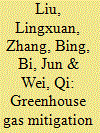

|
|
|
|
|
| Publication |
2012.
|
| Summary/Abstract |
Climate mitigation at the local level plays a highly important role in greenhouse gas (GHG) emissions mitigation. This research presents a summary of the local efforts in China's ecological industrial parks (EIPs) to assess GHG emissions and identify potential mitigation measures. Through field study and interviews in Suzhou Industrial Park (SIP), in Jiangsu Province, we conducted an energy-based GHG emissions inventory for SIP area from 2005-2010, with forecasts to 2015. The area emitted a total of 10.30 MMT CO2E in 2010. Three development strategies including business-as-usual (BAU), existing and pending regulations (EPR) and voluntary mitigating efforts (VME) were introduced to estimate the energy-related GHG emissions in 2015. The results projected that emissions will increase to 17.16 Mt in 2015 with no change in policy or practice, but 3.42 Mt of emissions are avoidable with full compliance with national and provincial energy policies (1.41 Mt), as well as local efforts (2.01 Mt). This study furthers the understanding of the potential effectiveness of carbon reduction strategies of industrial parks in China, including the development industrial symbiosis (IS) and on-site renewable energy projects.
|
|
|
|
|
|
|
|
|
|
|
|
|
|
|
|
| 4 |
ID:
114324


|
|
|
|
|
| Publication |
2012.
|
| Summary/Abstract |
Emission trading is considered to be a cost-effective environmental economic instrument for pollution control. However, the policy design of an emission trading program has a decisive impact on its performance. Allowance allocation is one of the most important policy design issues in emission trading, not only for equity but also for policy performance. In this research, an artificial market for sulfur dioxide (SO2) emission trading was constructed by applying an agent-based model. The performance of the Jiangsu SO2 emission trading market was examined under different allowance allocation methods and transaction costs. The results showed that the market efficiency of emission trading would be affected by the allocation methods when the transaction costs are positive. The auction allowance allocation method was more efficient and had the lowest total emission control costs than the other three allocation methods examined. However, the use of this method will require that power plants pay for all of their allowance, and doing so will increase the production costs of power plants. On the other hand, output-based allowance allocation is the second best method.
|
|
|
|
|
|
|
|
|
|
|
|
|
|
|
|
| 5 |
ID:
112892
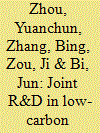

|
|
|
|
|
| Publication |
2012.
|
| Summary/Abstract |
China faces the dual challenges of climate change and increased energy demand. These challenges in turn increase the demand for wind energy development. Along with rapid growth in manufacturing capacity, Chinese companies have aspired to increase their innovation capacity in order to enhance their competitiveness in the market. Joint research and development (R&D) is an attractive path for Chinese companies striving to advance their R&D capacity. This paper examines joint R&D between Chinese wind-turbine manufacturing companies and foreign design firms, assessing the performance of joint R&D activities in China using the structure-conduct-performance (SCP) framework. The study found that joint R&D has improved Chinese companies' technical capacity, human resources and financial growth. However, the effect on Chinese companies' innovation capacity is still limited because of unequal technical capacities of the two sides in collaboration, as well as their preference for augmenting profits rather than technical capacity. Current joint R&D mode is only the extension of licensing mode in wind-turbine manufacturing industry.
|
|
|
|
|
|
|
|
|
|
|
|
|
|
|
|
| 6 |
ID:
133024


|
|
|
|
|
| Publication |
2014.
|
| Summary/Abstract |
Utilising a time-varying GAR (1)-TGARCH (1,1) model with different frequency data, we investigate the weak-form efficiency of major global crude oil spot markets in Europe, the US, the UAE and China for the period from December 2001 to August 2013. Our empirical results with weekly data indicate that all four markets have reached efficiency with few brief inefficient periods during the past decade, whereas the daily crude oil returns series suggest intermittent and inconsistent efficiency. We argue that the weekly Friday series fit the data better than the average series in autocorrelation tests. The evidence suggests that all four markets exhibit asymmetries in return-volatility reactions to different information shocks and that they react more strongly to bad news than to good news. The 2008 financial crisis has significantly affected the efficiency of oil markets. Furthermore, a comovement phenomenon and volatility spillover effects exist among the oil markets. Policy recommendations consistent with our empirical results are proposed, which address three issues: implementing prudential regulations, establishing an Asian pricing centre and improving transparency in crude oil spot markets.
|
|
|
|
|
|
|
|
|
|
|
|
|
|
|
|
| 7 |
ID:
177148
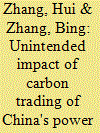

|
|
|
|
|
| Summary/Abstract |
Carbon trading is considered a strategy for reallocating carbon permits and reducing abatement costs that may also change energy consumption and the distribution of atmospheric pollution emissions, resulting in environmental health benefits or damage on a regional scale. In this research, we use an agent-based model to construct a national carbon emissions trading market of the power sector based on the year of 2013, and simulate the key atmospheric pollution emission patterns and the corresponding environmental health effects. We find that compared with a command and control policy, the carbon trading policy is able to reduce the CO2 emissions and save abatement costs by approximately 63.53 RMB/ton. Meanwhile, the results show the carbon trading policy would synergistically reduce PM2.5 emissions by 1.55 million tons. Addition, we use a simplified exposure-response model to estimate health benefits by synergistically reducing PM2.5 emissions, and find that the carbon trading policy would decrease 45,200 cases of all-cause mortality and generate 307.07 billion RMB in environmental health benefits. The co-benefit accounts for 0.52% of the nation's gross domestic product (GDP) in 2013. However, compared with the command and control policy, carbon trading changes the pollution emission distribution among the different provinces, and results in unintended environmental health damages in some provinces. Setting reasonable trading directions and exchange ratios, increasing stringency of environmental regulations in some provinces with worsening air pollution should be implemented to complement the carbon trading policy.
|
|
|
|
|
|
|
|
|
|
|
|
|
|
|
|
|
|
|
|
|